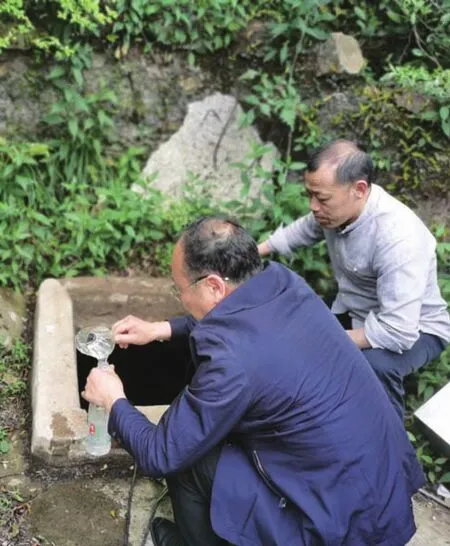灵波诗眼的海岛古井
2022-08-26林上军
文/林上军

舟山小沙潭陈井。The Tanchen Well in Xiaosha, Zhoushan city.
如果说大地是一首诗歌,那么水井便是大地的诗眼。每一口井背后都有文化的沉淀。
这或许是许多人的记忆 :在古朴的水井旁,有乡邻搓衣,有大树掩映;晚上歇工时分,更有诸多村民前来担水洗刷。一汪泉眼,终年不绝。倒影中的蓝天白云,常常被一只水桶搅飞。城市老街的石板路上,不经意间就会瞥见晃动着水波的古井。
我的纯真童年时代,就与老家的一口古井结下了难解之缘,它在我的记忆深处难以抹去。无论生活怎么变化,心中的那口古井依然是重要的、亲切的、温馨的印记。
水井史就是一部海岛史
舟山群岛特殊的海岛环境和水资源的先天不足,使得舟山生存史几乎可以说是一部求雨求水史。许多舟山水井,本身就是舟山历史的经历者和见证者。
据2016年出版的《舟山水利志》记载,仅舟山本岛就有7704口水井。2020年出版的《井里乾坤:舟山的井与井文化》一书,列举了舟山各县区比较有名且具有一定底蕴的水井266口。2021年12月,浙江省水利厅、浙江省文物局联合发出《关于加强古井水源保护的通知》,随后舟山市文物部门对舟山古井进行调查摸底,统计出文物类古井104处。
在这些水井中,有一口井的地位非常显赫,其名叫惠泉,位于舟山城北荷花池湾26—1号民居对面。舟山第一本地方志《四明图经 · 昌国》 对它专门进行记载:“惠泉井,在县东北一里,深二丈。邑人皆汲取之。尝有白蛇出现。皇朝端拱二年开凿。”
纵观舟山水井名字,或与衙门有关,如衙前左井、王衙同井;或与寺庙有关,与形状有关,与井的主人有关。从井的功能来分,有吃水井、酿酒井、洗涤井、民间崇信井等。岱山本岛有好几口井的水质非常优良,周围居民一直用井水酿酒。舟山长涂岛上有一口两眼水井,原是一个水潭,20世纪70年代,当地的渔农业队和运输社联手将其进行改造,如今水井北面石墙上尚有一个纪念碑。
舟山还有一些水井,形状虽然普通,但却很有特殊性。如位于定海岑港里钓山的爱乡井,为1991年台胞庄兴隆先生捐款1000美元所凿;长白岛上的腾家井,为新加坡侨胞腾宝友夫妇捐款所凿;坐落于定海小沙街道三毛祖居内的乡愁井,是1989年4月20日三毛回乡祭祖时取水带回台湾而得名。

海岛市民在萝卜井取水。A resident fetches water at the Turnip Well.
“无波古井水,有节秋竹竿。”古井是先民聚居生息的见证者和地方历史人文及乡愁的重要载体,维系着城镇、乡土文明的根脉。部分古井水源在海岛乡村至今仍作为生活水源的必要补充,承载着先辈日常的生活记忆。在漫漫的历史长河中,围绕水井等淡水资源,舟山群岛曾经上演过多少辛酸动人、惊心动魄的故事。
1988年,舟山嵊泗县嵊山岛久旱无雨,用水极端困难。11月13日,中国船舶燃料供应公司上海分公司“海供水5号”轮从上海载1000吨淡水送到嵊山。12月6日,舟山市慰问团送水抵达嵊山。嵊山中学里,有一位外岛的母亲来看望读书的儿子,她所带来的礼物中,有一瓶用玻璃瓶装的井水。那是母亲守候了大半夜,从村里枯竭的井里一点一点刮出来的井水。儿子留了半瓶,还有半瓶又让母亲带回去。
在舟山,至少有上万口水井,数量多、分布广,大小不一、形态各异的水井构成了舟山特有的自然景观,也由此催生了与井有关的各种文化习俗。水井,在舟山不仅是取水之地、生命之泉,同时刻凿着舟山的历史沿革、文化传承,甚至是舟山人不屈不挠与自然作斗争、与列强作斗争的印记。
一路寻找古井传奇
初夏时节,风和日丽,约三五好友,察舟山古井。
我们此行计划踏访舟山本岛七口古井,分布于定海石礁、岑港村落、紫薇侯家、小沙街道、五雷山顶、白泉皋泄、临城边缘。
头口井,坐落于石礁一小山坡脚下,走近一看,清澈见底,充满阳光味,真是好久没领略到如此令人心动的井水。井不深,旁边正有两三个妇女洗刷。她们告诉说,这叫萝卜井。至于井名的来历,有如此传说:清朝时,有一贫穷寡妇在紫薇槐花井洗萝卜,不小心,萝卜掉入井中不见了,寡妇见状,长呼短叹,心疼得久久不愿离去。此时,一位白胡子老翁来到跟前,对寡妇说,到附近莲花庵旁的井去,就能找到丢失的萝卜。寡妇便跑到此庵,找到井潭,发现丢失的萝卜果然漂浮其中。于是“萝卜井”之名便流传至今。据说这莲花庵,也有400多年的历史。
继续驱车,穿过岑港司前老街,峰回路转,抵达岑港方井。方井顾名思义口呈方形,中间一根石条,井圈边长约1.6米,横梁宽0.28米。这口井的奇特之处是旁边有敬神的香炉,是当地村民抬请井潭姑娘或做丧事人家念伴取水、焚香点烛时祈祷所用。井旁还有铭碑,上写:古井滋司前,乡贤倍珍惜,久饮方井水,延寿百年春……

岑港金水井。The Square Well at Cen’gang Port.
双桥侯家槐花井,则是因为井旁那株槐花树得名。槐花树宛如小家碧玉,冠叶郁郁葱葱,主干根部到离地一米高的地方,有一奇特生成,右侧均为半轮树皮。而槐花井则结构独特,一边筑有凭栏,井道伸展如坑道,井口长宽约1米左右,往井口一望,喜见里面还有两三条锦鲤悠然而行。恰好有83岁老妇黄亚花出来,她身朝那株并不高大但历史悠久的槐花、眼望着井潭介绍,这井至少有上百年历史,约20年前才筑起这一凭栏,是为了防止小孩掉到井里,并防止灰尘跑到井内。
2018年7月,定海区政府还在此为井树碑。据记载,这井还与紫微茶人谷内的金线龙潭女有关。黄亚花向我们娓娓道来:某年这一带大旱,水井枯竭,侯家一大户人家小姐心急如焚。她擅长绣龙,于是花了七七四十九天绣出一条黄鳞金爪、栩栩如生的金龙。绣完后,小姐将其放在阳台上,让金龙吸收日月精华。某日,金龙果然遇水现真身,欲腾空而起。小姐想把它转移至村庙里供奉,不料金龙就地一滚,携裹小姐朝狭门方向飞去,最后钻入一个深水潭……
古井,大多不但有神奇传说,更有古树覆盖。小沙的潭陈井,一棵大樟树,几乎笼盖井潭周边活动区域,井有200多年历史,老树也是历经沧桑。这井有1.4米×2.8米见方,井壁石条叠砌,水源充盈。也许是由于井口太大,又不注意呵护,同行熟悉者称:水质已不如从前。
“西有槐花开,东有潭陈井”,我们真切领略了定海西乡这两座古井的风采、神韵、底蕴。
白泉皋泄的老井—童家园水井,也有一棵老柿子树遮盖,下有三口井,一口封起来了。村民张伟康,年逾古稀,他自豪地对我们说,井约4米深。每次清淤,抽水机把井水抽干后,一晚上工夫水井就满了。那些嫁到城里的村妇,每次回老家总要装些井水回去。
而舟山本岛五雷山上的那口水井,虽没有单独被记载的历史故事,却也是源远流长;旁边茶园相伴,生态环保,沁人心扉。
最后一站是临城边缘的清泰寺,在此,我们汲取了50多米深处的甘冽山泉。
此次古井踏访之行,每到一处,大家都用手掬水洗脸明目,大呼清凉、润泽;有的还掬一把喝几口品咂,感觉回味绵长。
一路察井景、品井水,可谓美不胜收。水井边淘米、洗衣、冲澡,曾是许多人难忘的回忆。如今,人们汲井水不多,一些老井也被填埋,但如果想留住城市的根脉,唤醒城市的乡愁,不妨让一汪井泉永远汩汩流淌。
保节殉难正气凛然
舟山定海城北,古街尚存,古迹依旧。走进绿意葱郁的海山公园北侧,可见一口大井池,池面略呈正方形,池边立有“姚公殉难处”碑。
端详古碑,思绪回到1840年7月6日。当年鸦片战争爆发,英军攻陷定海东门,定海知县姚怀祥率众奋起抗敌。
姚怀祥,字斯征,号履堂,福建闽侯人,举人出身,历任象山、龙游和嵊县知县,后调任定海知县。
当时,他召集城中能战的军士等众人,与定海总兵张朝发一起布防,决定“坚守待援”,他一面派人向浙江提督及周围县城求援,又派典吏全福去周边乡村招募乡勇守城。可是,定海的兵力非常之少,民不识甲,军不识炮,那几尊还是明朝的红衣大炮,早已是古董般的摆设,他召集了城中所有能战、愿战之人,也不过区区六百人之数,兵器不足,只能棍棒农具凑合。
在战斗中,姚怀祥负伤。危急之际,他脱下衣冠并嘱咐随从转告家属:我不可保守兹土,死且有罪;汝辈,寇来勿贻我戚!”再脱下“身上夏布衫与所戴铜板边眼镜”交予他的胞弟姚怀铨,嘱云:“此物到时,便吾尽节时也!”英军步步进逼,姚怀祥从容跳入梵宫池自杀死节,时年58岁。
梵宫池不远处,还有一处舟山市级文保单位—“义士李先生殉难处”,镌刻于留方井旁。也是在1840年,英军入侵那年,定海军营书记李昌达誓死不屈,投留方井所在方河殉职,其妻房氏亦效夫继殉。清同治七年(1868),里人谷兰亭将方河填塞,建留方井,定海乡民感念李昌达夫妇之节,在方河处掘井三口,题镌“留方井”。
如今,留方井依然是定海城北部分市民每天洗刷之地,这一桶桶清凌凌的井水,不但洗刷着物质污垢,更是浸润着一种精神的洗礼。
Ancient Wells on Zhoushan Islands
By Lin Shangjun
If land is a poem, then water well is its essence. Behind every well there is culture that is worth digging into. My childhood of innocence is closely related to such an ancient well, which, no matter how life changes, holds a significant warm spot in my heart.
The history of Zhoushan islands is pretty much a waterseeking history, due to its unique geographical situation and natural lack of fresh water. Local water wells are thus the witnesses of local history. According topublished in 2016, there are 7,704 water wells on Zhoushan main island alone; 226 culturally famous water wells are listed in, a book published in 2020 on wells and their culture in Zhoushan.
You can always learn something from the wells’ names. Some suggest a relationship with governments, some with temples, some with their shapes, and so on. Speaking from the perspective of functions, there are water-drinking wells, brewing wells, washing wells, folk worshiping wells, etc.
Some of the wells, though ordinarily shaped, carry with them very special meanings. The Aixiang (homtown-loving) Well, for instance, was donated by a Taiwan compatriot named Zhuang Xinglong; the Tengjia (Teng’s family) Well was donated by the Tengs, an overseas Chinese couple living in Singapore; and the Xiangchou (nostalgia) Well inside Sanmao’s Former Residence was so named in 1989, after Sanmao (1943-1991) came back for ancestor worship and took some well water with her on her return to Taiwan.
Ancient wells are the witnesses of how ancestors had lived their lives. They also carry with them the local history and locals’nostalgia, as well as maintain the roots of local culture. Some ancient wells are still used as the supplementing water sources by villagers living on the island.
In 1988, there was a long drought on Shengshan Island in Zhoushan, resulting in a severe fresh water shortage. on November 13, the ship "Sea Water Supply No. 5" of the Shanghai branch of China Ship Fuel Supply Company delivered 1,000 tons of fresh water from Shanghai to Shengshan; on December 6, a delegation from Zhoushan city delivered water to Shengshan. At Shengshan Middle School, there was a mother who came from outside Zhoushan to see her young boy. One of the gifts she brought for her son was a glass bottle of well water — the result of her spending most of the night scraping bit by bit from an almost depleted well of her village. Her son kept half of the precious water and asked his mother to bring back the other half.

西沙角四眼井。Four wells on Xishajiao.
In Zhoushan, there are at least ten thousand wells, which are widely distributed and of different sizes and shapes. Together they constitute the unique natural and cultural landscapes of Zhoushan.
In an early summer day, my friends and I made a plan to visit seven ancient wells in Zhoushan, each located in a different place.
The first well we visited is located at the foot of a small hill. The water is so clear that we could see right through to the bottom, and it is brimming with the flavor of sunshine. The well is not deep, and several women were washing clothes next to it.They told me that it was called Turnip Well. The origin of the well's name could go back to the Qing dynasty (1616-1911): one day there was a poor widow washing a turnip in a well, which accidentally fell into the well and disappeared. At that moment, an old man with a white beard came and told her that she could find the lost turnip in the well near the Lotus Nunnery. The widow then ran to the nunnery and found her lost turnip floating in the said well, which was thus called the Turnip Well — a name passed down to this day.
Next, we drove to the Square Well at the Cen’gang Port.The Square Well, as the name implies, has a square mouth and a stone bar in the middle. It has a perimeter of 1.6 meters and a 0.28-meter-wide beam. The peculiar thing about this well is that a incense burner is placed nearby, which is used by the local villagers for special occasions such as funerals and praying rituals.
Then we went to the Sophora Flower Well at Shuangqiao.The well was so named because it is next to a sophora tree. The Sophora Flower Well has a unique structure with a railing built on one side, and a well hole stretching like a pit. The well mouth is one meter both in length and width, through which you can see two or three koifish swimming leisurely inside. In July 2018,the Dinghai government even made a monument here for the hundred-year-old well.
Most ancient wells are not only associated with legends, but are also guarded with ancient trees. The Tanchen Well in Xiaosha,for instance, is covered with a large camphor tree which almost envelops the entire activity area around the well. The well itself is more than 200 years old, so is the tree. The stone-stacked well is 1.4 meters in length and 2.8 meters in width, and is fully filled with water. Perhaps because the well is too large and has not been taken good care of, its water quality is not as good as before.
The Tongjiayua water well group is also covered by an old persimmon tree and has three wells under it, one of which is sealed up. And the well located besides a tea garden on the Wulei Mountain of the Zhoushan main island, though not historically recorded, also has a long history. Our last stop was Qingtai Temple at the edge of the city; here we drew the sweet mountain spring from a depth of more than 50 meters. At each stop of this wellvisiting trip, we all washed our faces using the cool and refreshing well water, and some of us also took a few sips.
In the north of Dinghai city of Zhoushan, the ancient streets with some ancient relics remain unchanged. Entering the north side of the lush green Haishan Park, you can see a large well pond named Fangong Pond with a slightly square surface and a"Martyring Site of Lord Yao" monument at the side of the pond,which commemorates General Yao’s sacrifice in safeguarding his homeland during the First Opium War in 1840.
Not far from the Fangong Pond, there is a Zhoushan Municipal Cultural Relics Protection Unit — "Martyring Site of Mr. Li". It is next to a well called the Liufang Well, which is in memory of the patriotic sacrifice of Mr. Li and his wife in 1840.
Today, some Dinghai citizens living in the north of the city still go to Liufang Well to do some washing every day. Buckets of crystal clear well water not only wash away the dirt but also dust off people’s soul.

舟山五雷山上的水井。The well on Wulei Mountain, Zhoushan city.
